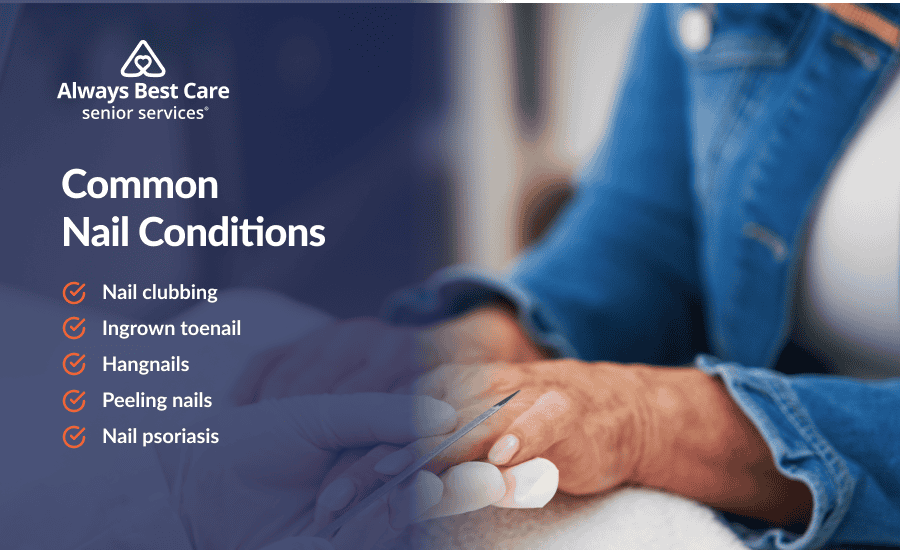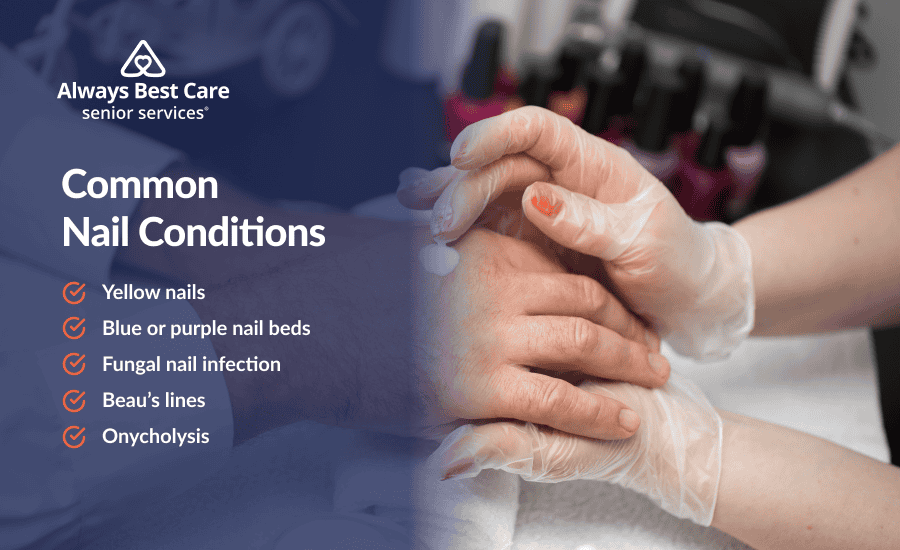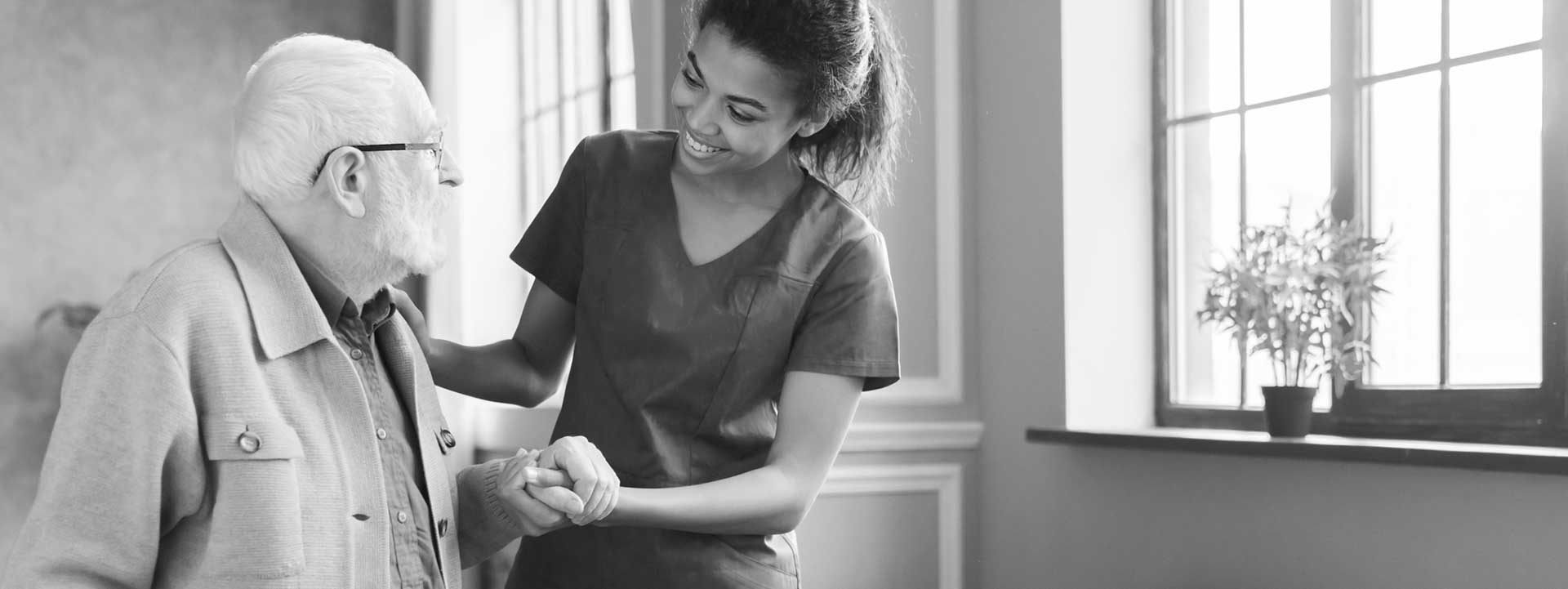In-Home Nail Cutting for Seniors [+ How To Find Podiatrists Near Me]
![In-Home Nail Cutting for Seniors [+ How To Find Podiatrists Near Me]](https://cdn.alwaysbestcare.com/wp-content/uploads/2025/02/senior-toenail-cutting-services-near-me.png)
Table of Contents
In-Home Nail Cutting for Seniors: Key Takeaways
- As you get older, nails can become thicker and more brittle, making them harder to trim and more prone to breaking or fungal infections
- Common nail conditions include nail clubbing, ingrown nails, and peeling nails
- Podiatrists are medical professionals who specialize in diagnosing and treating a wide range of foot and nail problems
Did you know that one in five people who walk into their doctor’s office is dealing with an ingrown toenail?
From ingrown toenails to fungal nail infections, personal hygiene and grooming for elderly individuals is often overlooked due to mobility limitations, cognitive decline, or a lack of awareness about the importance of regular foot care.
In this article, we will:
- Share common nail issues and foot problems experienced by the elderly
- Explore techniques for maintaining foot health in seniors
- Discover the advantages of professional grooming services
- Explain how our in-home care services at Always Best Care can prevent and manage common nail conditions in the elderly
What Happens to Your Nails as You Age?
As you get older, you might notice your nails looking a little different. Maybe a bit duller, more brittle, or even slightly yellow.
Toenails might thicken and harden, increasing the risk of ingrown toenails. On the other hand, fingernails are prone to breaking, especially at the tips.
Lengthwise ridges often develop in both fingernails and toenails as part of the natural aging process.
If you notice significant changes such as pits, prominent ridges, or odd-looking nail shapes, consult your healthcare provider.
These symptoms could indicate underlying health issues like iron deficiency, kidney disease, or other nutritional deficiencies.
10 Common Nail Conditions
Believe it or not, a podiatrist, or foot doctor, can tell a lot about your overall health just by looking at your toenails or your foot.
Changes in color, shape, or thickness can be signs of what’s going on inside the body, especially for older adults.
Here are some of the most common nail issues podiatrists encounter:
1. Nail Clubbing
Nail clubbing is a condition in which your nails become wider, sponge-like, or swollen, resembling an upside-down spoon.
Clubbing often signals underlying issues with your heart, lungs, or digestive system. Treating the underlying illness can help restore your nails to their normal appearance.
2. Ingrown Toenail
Typically affecting the big toe, ingrown toenails take place when the corner or side of a toenail grows into the soft flesh, causing pain, inflamed skin, swelling, and sometimes infection.
If you have diabetes or a medical condition that restricts blood circulation to your feet, such as peripheral arterial disease, you experience a higher risk of complications from ingrown toenails.
3. Hangnails
Hangnails, more common in fingernails than toenails, develop when the skin along the nail edge tears or becomes damaged. This sometimes causes bleeding and persistent, low-grade pain.
Dry skin, trauma to the fingers, or ingrown nails can cause hangnails.
4. Peeling or Splitting Nails
Onychoschizia is the medical term for peeling or splitting fingernails.
It happens due to the nail’s keratin structure, the same protein found in hair. Nails consist of multiple tough layers that can peel when exposed to repeated cycles of wetting and drying, making them dry and brittle.
This disorder often worsens in low humidity and during winter due to dry heat, leading to thin, weakened nails prone to splitting.
5. Nail Psoriasis
Nail psoriasis is an autoimmune condition that accelerates the reproduction of skin cells, leading to changes in the nails of both the fingers and toes.
This type of psoriasis typically occurs with a psoriatic rash on other body parts. Elderly individuals and those with psoriatic arthritis are prone to developing psoriatic nails.

6. Yellow Nails
Yellow nail syndrome is a rare disorder characterized by thick, yellow nails. Individuals with yellow nail syndrome may also experience respiratory issues, and leg swelling, typically affecting adults over 50.
Causes of yellow nails include fungal infections, smoking, vitamin E deficiency, and medications such as D-penicillamine.
7. Blue or Purple Nail Beds
Blue fingernails, or cyanosis, happen when your blood lacks sufficient oxygen. This is often due to cold temperatures.
Cyanosis can also indicate more serious health issues, such as respiratory or cardiovascular problems, where oxygen levels in the blood are chronically low.
8. Fungal Nail Infection
Fungal nail infections are common and contagious. Known as onychomycosis or tinea unguium, they happen when fungi that naturally live on your nails multiply out of control.
The most common cause of this condition is a group of fungi called dermatophytes.
9. Beau’s Lines
Beau’s lines are horizontal ridges or dents that appear in one or more of your nails, often caused by an illness or injury that interrupts nail growth.
Chronic conditions that disrupt blood flow to the nail matrix, such as hypothyroidism, diabetes, peripheral artery disease (PAD), and Raynaud’s phenomenon, can also cause Beau’s lines.
10. Onycholysis
Onycholysis refers to the condition where a nail detaches from the underlying nail bed. This separation can result from trauma, infection, or other skin disorders like dermatitis or psoriasis.
With proper treatment, the nail can reattach as it grows back.

How Can Seniors Manage Nail Conditions?
It’s easy for nail care to fall by the wayside when medical or mobility issues get in the way. But with a few simple steps, you can help your loved one stay comfortable and avoid potential problems.
1. Consult a Podiatrist
Visit a podiatrist regularly for preventive care, especially if your loved one has diabetes. Diabetes can cause delayed healing and foot problems, such as diabetic foot infection (DFI).
A podiatrist is a healthcare professional who cares for the feet and lower legs. They can help elderly individuals by safely trimming their toenails and checking for issues such as infections, poor circulation, or other foot problems.
2. Air Out Your Elderly Loved One’s Feet
Wearing shoes around the house can create a warm, moist environment where fungus can thrive. To decrease the risk of fungal infections, expose your elderly loved one’s feet and toenails to fresh air.
Also, make sure your elderly loved one’s feet and toes are completely dry before they put on socks, slippers, or shoes, to further prevent fungal infections.
3. Ensure Your Elderly Loved One Eats the Right Diet
Foods such as fruits, leafy greens, lean meats, salmon, beans, eggs, nuts, and whole grains, along with essential nutrients like calcium and vitamins A, B, and C, help support strong and healthy nails.
Your loved one’s healthcare provider can suggest the best foods or supplements to support nail health.
The great news is that our caregivers at Always Best Care can turn those nutritious ingredients into tasty, satisfying meals.
4. Trim Nails Regularly
Regularly trimming your elderly loved one’s nails helps reduce the spread of germs and infection by removing the dirt, dead skin, and debris that can accumulate underneath.
Check nails weekly and trim or file as necessary. For older adults with thicker nails, trimming them after a warm bath or shower can help soften the nails.
5. Practice Good Nail Hygiene
Maintain excellent nail hygiene by cutting your elderly loved one’s nails straight across with sharp manicure scissors or clippers, then gently rounding the tips into a curve.
6. Discourage Nail Biting
Educate or remind your elderly loved one about the consequences of nail biting, including weakened nails and increased risk of spreading germs. Offer stress relief alternatives such as stress balls or fidget toys to stop the habit.
Regular manicures can also help maintain nail health and minimize the temptation to bite.
7. Use a Moisturizer
Our nails naturally have low oil and moisture content, making them prone to dryness and brittleness. Moisturize your elderly loved one’s nails by massaging hand lotion into their fingernails and cuticles.
Your elderly loved one can also use a nail moisturizer that contains vitamins and natural oils to further hydrate and strengthen their nails.
How Can I Find Podiatrists Near Me?
Need help finding toenail cutting services nearby? Let’s get your elderly loved one pointed in the right direction.
1. Use Google With Your Location
Search:
- “Toenail cutting services for seniors near me”
- “Mobile foot care nurse near [your city]”
- “Elderly foot care services in [your ZIP code]”
This will bring up local podiatrists, mobile foot care services, or in-home care agencies nearby.
2. Ask Your Doctor or Local Pharmacy
Start by chatting with your loved one’s doctor; they’re often a great first step and can usually recommend a trusted podiatrist or even a mobile foot care nurse who makes house calls.
You can also check with local pharmacies or clinics, as they often keep referral lists for providers in your area.
3. Check Senior Centers or Aging Agencies
Search for your Area Agency on Aging. These offices often keep lists of:
- Local foot care clinics
- Free or low-cost senior podiatry events
- Mobile providers serving homebound individuals
Find In-Home Nail Cutting for Seniors at Always Best Care
In-home nail cutting for seniors can help keep feet healthy by preventing common issues like ingrown nails, infections, and other problems that can come from nails not being trimmed properly.
Whether your elderly loved one needs to treat a fungal infection or simply wants an eye-catching mani-pedi, our in-home nail cutting services for seniors can guarantee proper nail care for both health and aesthetic appeal.
Our caregivers undergo expert training and extensive background checks to make sure they are well-equipped to address the delicate needs of aging feet and hands.
We meticulously maintain hygiene and use sterile tools to minimize infection risks and improve overall well-being.
Senior Toenail Cutting Services Near Me: FAQs
Why is toenail care important for seniors?
As we get older, toenails can become thicker, harder to trim, and more prone to issues like ingrown nails, fungal infections, or pressure sores.
Regular care helps prevent discomfort and keeps feet healthy and clean, which is especially important for seniors with mobility or health concerns.
Can someone come to my loved one’s house to do this?
Absolutely! Many providers now offer mobile foot care services and will come right to your door. It’s a great option for seniors who have trouble getting out or just prefer the comfort of home.
Can my elderly loved one get senior toenail cutting services at a nail salon?
Yes, your elderly loved one can go to a nail salon for toenail cutting.
What if my loved one has diabetes or circulation problems?
In those cases, toenail care should be handled by someone with medical training, like a podiatrist or a foot care nurse.
People with diabetes or poor circulation are more likely to develop infections, delayed healing, or foot ulcers from minor cuts, so extra caution during nail care is essential.





